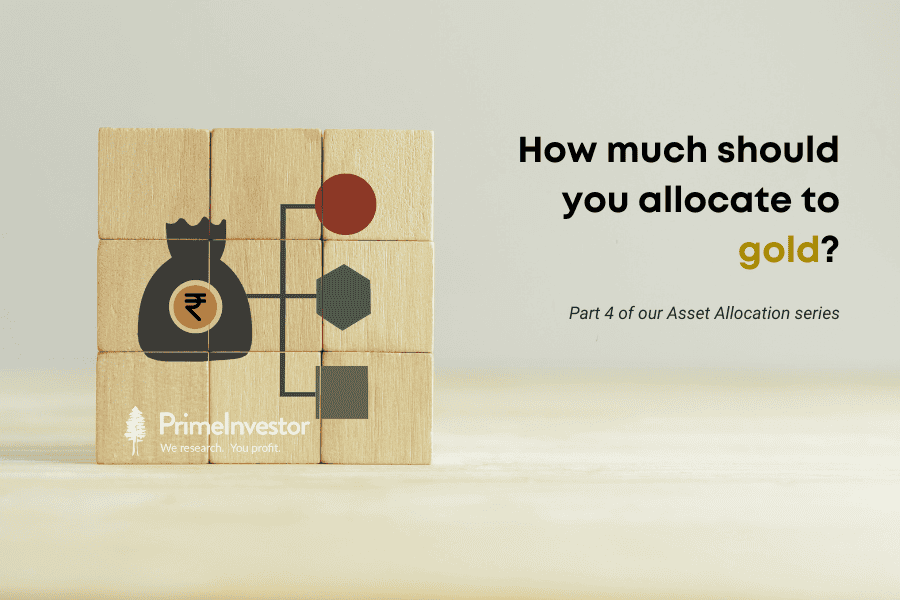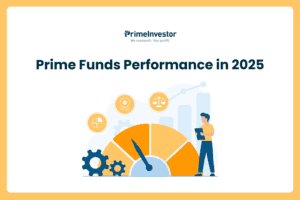With inputs from Bipin Ramachandran
With gold prices setting new records recently, returns from the asset have begun to look quite dazzling and we’ve been asked this – ‘How much should you allocate to gold?’ Many investors have even asked if they should be having say, a 50% or higher gold allocation in their portfolio. We answered this question in our podcast: Should you buy gold now?
To gauge what the gold allocation should be and what gold does to the risk-return profile portfolios, we ran the numbers on our 20-year asset allocation model.
(Please note that numbers in this article may be slightly different from the previous ones on asset allocation, because we updated the data until April 2024)
Here’s what we found.

Gold in a 10-year portfolio
In our earlier article on best asset allocation, we concluded that if your goal is 10 years away, an all-equity portfolio can maximise your returns while lowering the probability of losses to almost zero. What value can gold add to a 10-year portfolio?
We found out by adding various doses of gold to an equity-only portfolio. The model ran a rolling return analysis on equities, debt and gold on historical data for the period from January 2003 to April 2024. The Nifty100 index is proxy for equities, SBIL Gilt Fund for debt and Indian gold prices from the ICRA database for gold. Here are the results.
The analysis shows that in the last 20 years, an investor who added a gold allocation to an equity portfolio, experienced the following:
- Higher the gold allocation, higher the average rolling returns of the portfolio. As the investor went from a 0% gold allocation to a 40% allocation, the portfolios’ average rolling returns improved from 12.1% to 13.4%. This is probably because gold performed when equity returns were poor.
- But contrary to perception, allocation to gold lead to more volatile portfolio returns. The standard deviation of portfolio returns rising steadily with a higher gold allocation demonstrates this. A rising gold allocation also didn’t shrink the gap between the maximum and minimum returns for the portfolio. This makes it important to look at risk-adjusted returns when adding gold to the portfolio.
- A gold allocation improved the investor’s odds of beating inflation (more than 6% return). But this benefit topped out at a gold allocation of 20%.
- The Sharpe ratio for the portfolio jumped sharply (1.76 to 1.95) when the investor went from 100% equity to a 10% gold allocation and inched up to 2.01 with a gold allocation of 20%. But beyond this, the Sharpe ratio fell. This suggests that the ideal gold allocation was between 10% and 20%. We think it should be closer to 10% than 20% today, for reasons we’ll explain at the end.
Gold in medium-term portfolios
Does adding gold to an equity-only portfolio make it more suitable for investors with 3-year or 5-year goals? We ran the numbers below.
The data shows that adding gold to 3-year and 5-year equity portfolios did three things. It improved the average rolling returns, reduced the probability of losses and contained losses in the worst periods. But the standard deviation of these portfolios remained quite high and a wide gap between the best and worst periods persisted. The Sharpe ratios were also not that great at 0.87 to 1.23. Therefore, adding a gold allocation to equity portfolios over 3 and 5-year holding periods did not generate great returns for the risks taken. This is because both equities and gold are highly volatile assets.
This reinforces the point that investors cannot do away with an allocation to debt in medium-term portfolios, if they would like predictability in outcomes.
Gold in portfolios with debt
Adding a 10% gold allocation to conventional portfolios with 50-50 or 65-35 equity-debt mixes, yielded the following results.
The above exercise captured returns for equity-debt portfolios when we replaced 10% of equity or debt allocations with gold. It showed the following:
- Replacing either 10% of either equity or debt with a gold allocation significantly improved the investor’s chances of beating inflation (assumed at 6%). It also lifted returns in the worst periods.
- Portfolios with 10% gold delivered improved Sharpe ratios compared to those with just equity and debt, whether with a 50-50 allocation or 65-35 allocation.
- Replacing the debt portion in the portfolio with gold while holding equity constant, lifted the overall returns. But it also increased volatility of returns. Replacing the equity portion with gold made for lower returns. But it reduced volatility and improved the chance of beating (6%) inflation. Overall, replacing equity with gold delivered a better risk-adjusted return experience (Sharpe ratio) than substituting debt with gold for the above time frames.
Final takeaways - so how much should you allocate to gold?
To summarise, the key takeaways from the analysis are the following.
- Adding a gold allocation to an equity portfolio improved its average returns and its odds of beating inflation. But did not reduce volatility in portfolio returns.
- Risk-adjusted returns improved sharply as an investor added 10% or 20% gold to an equity portfolio. But allocations beyond that did not help.
- Allocations to gold improved returns from equity portfolios over 3 year and 5-year horizons too. But without debt, the risk-adjusted returns were unattractive.
- Adding a gold allocation of 10% to a conventional 50-50 or 65-35 equity-debt portfolio markedly improved risk-adjusted returns. It was better to replace equity with gold for a better Sharpe ratio over medium time frames.
While the results of this analysis may tempt investors to add gold allocation of 20% or more, we would not recommend this for three reasons.
- Gold’s unusually strong run in the past year has lifted its rolling returns over 3-year, 5-year and 10-year periods. Recent gold returns have been sparked by central bank buying on the back of worries about a US debt crisis and geopolitical tensions, even as traditional sources of gold demand have been muted. Therefore, investors need to budget for a mean reversion in gold and not extrapolate recent returns into the future.
- Unlike equities or bonds which deliver cash flows to the investor, gold does not yield any regular cash flows. Gold prices are also entirely determined by demand supply dynamics at any given point in time. While stock prices are supported by growing underlying earnings and bond prices by the yield, gold has no underlying. This makes it a far riskier asset to own than either equities or debt in fundamental terms.
- We are also wary of recommending a large allocation to any asset whose value hinges entirely on the public perception.







16 thoughts on “How much should you allocate to gold? ”
Thanks for posting this article AK. Could you clear one doubt from the following quote.
“Adding a gold allocation of 10% to a conventional 50-50 or 65-35 equity-debt portfolio markedly improved risk-adjusted returns. It was better to replace equity with gold for a better Sharpe ratio over medium time frames.”
Say I have a current equity:debt allocation of 96:4 and would gradually move it to 50:50 with age. How does a 10% gold allocation fit in this equation?
Would it be:
a) current equity:debt allocation is 96:4 where gold accounts for 10% of the equity portfolio allocation (9.6% of entire portfolio) and at a equity:debt allocation of 50:50 it would account for 10% of the equity portfolio allocation (5% of entire portfolio) or
b) current equity:debt:gold allocation is 86:4:10 where gold accounts for 10% of the entire portfolio and at a equity:debt:gold allocation of 40:50:10 it would still hold 10% weight of the entire portfolio
In case a) gold has a 10% allocation of the equity portfolio where as in case b) it has a 10% allocation of the entire portfolio.
The second option. Gold at 10% of overall portfolio with the allocation coming out of equity
Thanks for clearing that.
I’m following an age based equity:debt ratio allocation (https://www.reddit.com/r/Bogleheads/s/tKPGvPr2r1) which starts at 96:4 at 20 yrs all the way to 30:70 at 100 yrs. However I’ve capped it at 60:40 at 58 yrs so an equity:debt:gold allocation would be 50:40:10.
What are your thoughts on progressively increasing gold’s allocation (0 to 10%) per age bracket instead of starting off with a fixed 10% allocation?
No I don’t think the gold allocation should rise with age as gold has long spells of poor returns of losses. Its not as reliable as debt
That makes sense. Thanks for sharing your insights
Zerodha has a new FOF (Equity & Gold) pending with SEBI – https://www.sebi.gov.in/filings/mutual-funds/may-2024/zerodha-equity-and-gold-fof-annexure-1-scheme-information-document_83477.html
Its 40% into Nify 100, 30% into Midcap 150 & 30% into Gold. Re balance done at 5% threshold across asset classes. I found this to be a good one to manage with another index fund, NPS T2 (for debt) to keep Gold at 15% of portfolio.
Hello Aarati, Superb article with all the data points, giving the right perspective about having Gold as a part of the portfolio. I am sure this requires a lot of time, effort and data crunching. Kudos to your team.
Is it possible to make a similar comparison of the optimum portfolio with Nifty 100, SBI Gilt, Gold and US equities (say Nasdaq 100). This probably will give the most all round portfolio. My personal portfolio has this combination and would be very happy to learn if it works and the optimum allocation to each asset.
Thanks
Thank you. Yes we will try this out. Only constraint is the short track record of US funds.
Thank you for your feedback. I guess it maybe possible for 10 yrs as Motilal Oswal Nasdaq 100 ETF has been in existence since 2012 if my memory serves me right.
A very good article with proper data and statistics. Thanks for the information.
Dear Aartiji and Team
Very insightful article and very lucid for layman to understand. Good alert at the end about not jumping to add gold.
To benefit from such insights in real life , I would like to know
1. For your analysis, you have assumed certain proxies for equity(Nifty 100), debt (SBI guilt)and gold. In real life situation one is unlikely to have such investment pattern
2. Hence how does one go to analyze his own portfolio to adjust asset allocation. One will have at least 4/5 MF for equity, PPF/FD/Bonds for debt.
3. Is possible to analyze one actual portfolio to adjust asset allocation?
I have been utilizing services of a certified financial planners for last several years but none is equipped to handle such a situation. Is any resource available which can be of help? In absence of that such insights largely remain of academic interest or there is a way forward?
Thanks and Regards
Dipak
We did this with Excel only sir so should be possible for your financial advisor to do
Thanks for insights. Btw what is best way to invest in gold ? Do we have any article on it or if not – can you pls guide.
Sovereign gold bonds or ETFs..we have written on the subject..
Dear Aarati / Team PI,
Grateful for this article.
Thanks and Regards
Oh thank you🙏
Comments are closed.